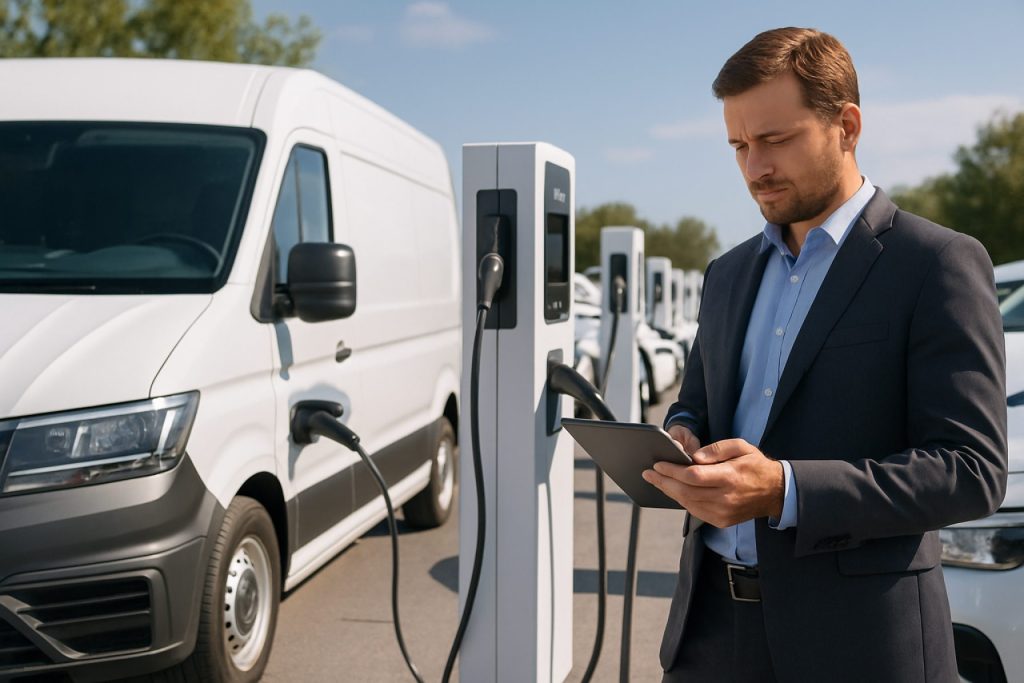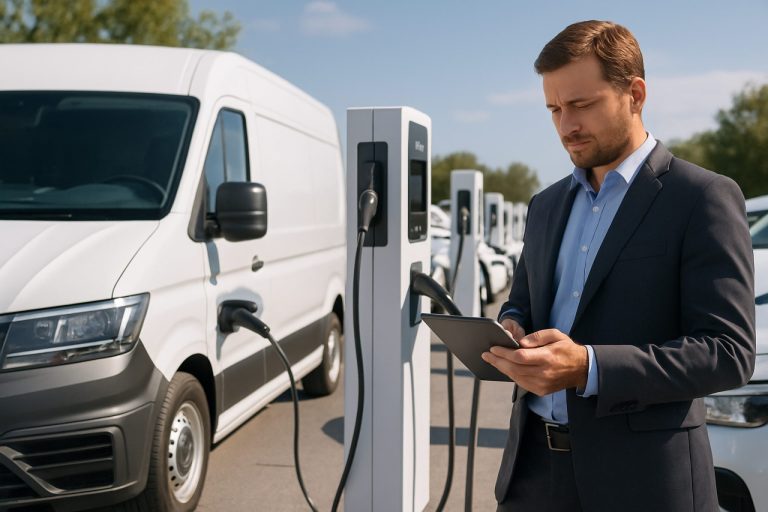
Unlocking the Future of Energy Management for EV Fleets in 2025: How Smart Technologies and Strategic Planning Will Drive Efficiency, Cost Savings, and Sustainability for Fleet Operators Worldwide.
- Executive Summary: Key Trends and Market Outlook (2025–2030)
- Market Size, Growth Forecasts, and Adoption Rates (2025–2030)
- Regulatory Drivers and Policy Landscape for EV Fleet Energy Management
- Core Technologies: Smart Charging, V2G, and Energy Storage Integration
- Fleet Electrification Strategies: Transition Pathways and Best Practices
- Energy Cost Optimization: Dynamic Pricing, Load Management, and Renewable Integration
- Key Players and Industry Ecosystem: OEMs, Utilities, and Tech Providers
- Case Studies: Leading EV Fleet Deployments and Energy Management Solutions
- Challenges and Barriers: Infrastructure, Interoperability, and Data Security
- Future Outlook: Innovations, Investment Opportunities, and Market Growth (CAGR 2025–2030 ~18%)
- Sources & References
Executive Summary: Key Trends and Market Outlook (2025–2030)
The period from 2025 to 2030 is poised to be transformative for energy management in electric vehicle (EV) fleets, driven by rapid electrification, grid modernization, and the integration of advanced digital solutions. As commercial and municipal fleets accelerate their transition to electric vehicles, the need for sophisticated energy management systems (EMS) is becoming paramount to optimize charging, reduce operational costs, and support grid stability.
A key trend is the widespread adoption of smart charging infrastructure, which enables dynamic load management and demand response. Major charging solution providers such as ABB and Siemens are deploying intelligent charging platforms that allow fleet operators to schedule charging based on real-time electricity prices and grid conditions. These systems are increasingly integrated with fleet management software, providing operators with granular control over energy consumption and vehicle readiness.
Vehicle-to-grid (V2G) technology is also gaining traction, allowing EV fleets to not only draw power from the grid but also return stored energy during peak demand periods. Companies like Nissan Motor Corporation and Enel are piloting V2G projects with commercial fleets, demonstrating the potential for fleets to become active participants in energy markets and generate new revenue streams. By 2030, V2G is expected to be a standard feature in many fleet EMS offerings, particularly in regions with high renewable energy penetration.
Data-driven optimization is another defining feature of the evolving market. Telematics and IoT platforms from providers such as Geotab and Volvo Cars are enabling real-time monitoring of vehicle state-of-charge, route planning, and predictive maintenance, all of which contribute to more efficient energy use. These capabilities are critical as fleets scale up and as utilities seek to balance increased EV load with grid reliability.
Looking ahead, regulatory support and incentives are expected to further accelerate the adoption of advanced EMS solutions. Governments in North America, Europe, and parts of Asia are setting ambitious targets for fleet electrification and investing in grid infrastructure upgrades. By 2030, the convergence of policy, technology, and market demand is projected to make energy management a central pillar of fleet operations, with significant implications for cost savings, sustainability, and grid resilience.
Market Size, Growth Forecasts, and Adoption Rates (2025–2030)
The market for energy management solutions tailored to electric vehicle (EV) fleets is poised for significant expansion between 2025 and 2030, driven by accelerating fleet electrification, regulatory mandates, and the need for cost optimization. As commercial and municipal fleets transition from internal combustion engine vehicles to EVs, the complexity of managing charging schedules, grid interactions, and energy costs has created a robust demand for advanced energy management systems (EMS).
By 2025, global EV fleet adoption is expected to reach a critical inflection point. According to industry data, commercial EV fleet sales are projected to account for a substantial share of new vehicle registrations, particularly in regions with strong policy support such as the European Union, the United States, and China. Major automakers and fleet operators—including Ford Motor Company, Daimler Truck, and Volkswagen Group—have announced aggressive electrification targets for their commercial vehicle portfolios through 2030.
The energy management segment is expected to mirror this growth. Industry leaders such as Siemens, ABB, and Schneider Electric are expanding their offerings to include integrated EMS platforms that optimize charging, leverage time-of-use tariffs, and enable vehicle-to-grid (V2G) capabilities. These platforms are increasingly being adopted by large fleet operators and logistics companies to reduce operational costs and ensure grid stability.
Adoption rates for EMS among EV fleets are forecast to rise sharply. By 2030, it is anticipated that a majority of medium and large EV fleets in developed markets will deploy some form of advanced energy management, with penetration rates exceeding 60% in sectors such as last-mile delivery, public transit, and municipal services. This trend is supported by ongoing investments in charging infrastructure and digitalization by companies like Enel and EDF, which are also developing energy management solutions tailored to fleet needs.
- In 2025, the global market value for EV fleet energy management solutions is estimated to be in the low single-digit billions (USD), with compound annual growth rates (CAGR) projected in the 20–30% range through 2030, according to industry consensus.
- Key growth drivers include regulatory requirements for zero-emission fleets, rising electricity costs, and the increasing sophistication of EMS platforms.
- Emerging markets in Asia and Latin America are expected to see rapid adoption post-2025, as local governments and utilities ramp up electrification initiatives.
Looking ahead, the convergence of fleet electrification, smart charging, and grid integration will make energy management a central pillar of operational strategy for fleet operators worldwide.
Regulatory Drivers and Policy Landscape for EV Fleet Energy Management
The regulatory and policy landscape for energy management in electric vehicle (EV) fleets is rapidly evolving in 2025, driven by ambitious decarbonization targets, grid modernization efforts, and the need to optimize energy use as fleet electrification accelerates. Governments and regulatory bodies across North America, Europe, and Asia-Pacific are enacting mandates and incentives that directly impact how fleet operators manage charging, grid interaction, and energy procurement.
In the United States, the U.S. Environmental Protection Agency (EPA) and the U.S. Department of Transportation (DOT) are enforcing stricter emissions standards for medium- and heavy-duty vehicles, with phased requirements through 2032. These regulations are pushing public and private fleets to adopt EVs and implement advanced energy management systems to ensure compliance and cost-effectiveness. The U.S. Department of Energy (DOE) is also supporting fleet electrification through grants and technical assistance, emphasizing smart charging and vehicle-to-grid (V2G) integration.
At the state level, California’s Advanced Clean Fleets rule, administered by the California Air Resources Board, requires a phased transition to zero-emission vehicles for public and private fleets, with interim targets in 2025 and 2030. This regulation is a bellwether for other states, many of which are adopting similar frameworks. These policies are accelerating the deployment of energy management platforms that optimize charging schedules, reduce demand charges, and enable participation in demand response programs.
In the European Union, the European Automobile Manufacturers' Association and the European Commission are advancing the “Fit for 55” package, which includes binding targets for fleet emissions and infrastructure requirements for smart charging. The Alternative Fuels Infrastructure Regulation (AFIR), effective from 2025, mandates minimum charging infrastructure and interoperability standards, compelling fleet operators to adopt energy management solutions that ensure compliance and grid stability.
China continues to lead in EV adoption and grid integration, with the State Grid Corporation of China and the Ministry of Industry and Information Technology promoting V2G pilots and dynamic pricing to encourage off-peak charging. These initiatives are shaping global best practices and influencing regulatory approaches in other markets.
Looking ahead, regulatory momentum is expected to intensify, with more jurisdictions introducing zero-emission fleet mandates, time-of-use tariffs, and incentives for grid-friendly charging. This evolving landscape will require fleet operators to invest in sophisticated energy management systems, collaborate with utilities, and stay agile to comply with emerging standards while optimizing operational costs and sustainability outcomes.
Core Technologies: Smart Charging, V2G, and Energy Storage Integration
The rapid electrification of commercial vehicle fleets is driving significant advancements in core energy management technologies, particularly smart charging, vehicle-to-grid (V2G), and energy storage integration. As of 2025, these technologies are increasingly being deployed to optimize operational costs, grid impact, and sustainability for electric vehicle (EV) fleets.
Smart Charging is foundational for fleet energy management, enabling dynamic control over when and how vehicles are charged. This technology leverages real-time data on electricity prices, grid demand, and fleet schedules to minimize costs and avoid peak demand charges. Major charging infrastructure providers such as ABB and Siemens have developed advanced smart charging platforms that integrate with fleet management systems, allowing operators to automate charging based on vehicle availability and energy tariffs. In 2025, the adoption of smart charging is expected to accelerate, driven by regulatory incentives and the need for grid-friendly charging solutions.
Vehicle-to-Grid (V2G) technology is gaining traction as a means for fleets to not only draw power from the grid but also return stored energy during periods of high demand. This bidirectional capability transforms EVs into distributed energy resources, supporting grid stability and creating new revenue streams for fleet operators. Companies like Nissan and Renault Group are piloting V2G projects with commercial partners, while charging solution providers such as Enel are rolling out V2G-compatible infrastructure. By 2025, regulatory frameworks in regions like Europe and parts of North America are expected to further enable V2G participation, with pilot programs expanding into larger-scale deployments.
Energy Storage Integration is becoming increasingly important for fleet depots, especially those with high power requirements or limited grid capacity. Stationary battery systems, often supplied by companies like Tesla and LG, are being installed alongside charging infrastructure to buffer demand, store renewable energy, and provide backup power. These systems help fleets avoid costly grid upgrades and take advantage of time-of-use pricing. In 2025 and beyond, the integration of on-site solar generation with battery storage and smart charging is expected to become a best practice for large fleet operators, further reducing carbon footprints and operational costs.
Looking ahead, the convergence of these core technologies is set to redefine energy management for EV fleets. As interoperability standards mature and digital platforms become more sophisticated, fleet operators will gain unprecedented control over their energy use, supporting both business objectives and broader grid decarbonization goals.
Fleet Electrification Strategies: Transition Pathways and Best Practices
As fleet electrification accelerates in 2025, energy management emerges as a critical pillar for operational efficiency, cost control, and grid stability. The transition from internal combustion engine (ICE) vehicles to electric vehicles (EVs) introduces new complexities, particularly in managing charging infrastructure, optimizing energy use, and integrating renewable sources.
A key trend is the deployment of smart charging solutions that align vehicle charging with grid conditions and fleet schedules. Companies such as Enel X and ABB are at the forefront, offering advanced charging management platforms that enable load balancing, demand response, and real-time monitoring. These systems help fleets avoid peak demand charges and leverage off-peak electricity rates, which is increasingly important as utilities introduce dynamic pricing models.
Energy storage integration is gaining traction, with battery energy storage systems (BESS) being paired with fleet charging depots. This approach, championed by companies like Tesla and Siemens, allows fleets to store energy during low-cost periods or from on-site renewables, then discharge during high-demand intervals. Such strategies not only reduce operational costs but also support grid resilience by providing ancillary services.
Renewable energy sourcing is another best practice, with many fleets committing to power their EVs with clean electricity. Partnerships between fleet operators and renewable energy providers, such as ENGIE and EDF, are enabling direct procurement of solar and wind power, either through on-site installations or power purchase agreements (PPAs). This not only reduces carbon emissions but can also insulate fleets from volatile energy prices.
Data-driven energy management is becoming standard, with telematics and IoT platforms providing granular insights into vehicle usage, charging patterns, and energy consumption. Companies like Geotab and Shell (through its Shell Recharge Solutions) are developing integrated platforms that help fleet managers optimize routes, schedule charging, and forecast energy needs.
Looking ahead, the outlook for 2025 and beyond points to greater integration between fleet operations, energy markets, and the grid. Vehicle-to-grid (V2G) technology, piloted by firms such as Nissan and Renault Group, is expected to move from demonstration to early commercial deployment, allowing fleets to provide grid services and unlock new revenue streams. As regulatory frameworks evolve and technology matures, energy management will remain central to the success and scalability of EV fleet electrification.
Energy Cost Optimization: Dynamic Pricing, Load Management, and Renewable Integration
Energy cost optimization is a critical focus for electric vehicle (EV) fleet operators in 2025, as electricity prices fluctuate and grid constraints intensify. The convergence of dynamic pricing, advanced load management, and renewable energy integration is shaping the strategies of leading fleet managers and technology providers.
Dynamic pricing—where electricity rates vary based on demand and grid conditions—has become increasingly prevalent in major markets. Utilities and grid operators are expanding time-of-use (TOU) and real-time pricing programs, incentivizing fleets to charge during off-peak hours. For example, Southern California Edison and National Grid have rolled out commercial EV charging tariffs that reward flexible charging behavior, directly impacting fleet operating costs.
To capitalize on these pricing signals, fleet operators are deploying sophisticated load management systems. These platforms use predictive analytics and automated controls to schedule charging sessions, balance loads across multiple vehicles, and avoid costly demand charges. Companies like ABB and Siemens have introduced energy management solutions that integrate with fleet telematics and utility data, enabling real-time optimization of charging schedules. In 2025, these systems are increasingly leveraging artificial intelligence to forecast fleet usage patterns and grid conditions, further enhancing cost savings.
Renewable energy integration is another key trend, as fleets seek to reduce both costs and carbon footprints. On-site solar installations, often paired with battery storage, allow fleets to self-generate clean electricity and hedge against volatile grid prices. Tesla and Enel are among the companies offering turnkey solar-plus-storage solutions tailored for commercial EV depots. These systems can be programmed to prioritize charging from renewables when available, or to discharge stored energy during peak pricing periods.
Looking ahead, the outlook for energy cost optimization in EV fleet management is shaped by regulatory support and technological innovation. Governments in North America, Europe, and Asia are expanding incentives for smart charging and distributed energy resources, while grid operators are piloting vehicle-to-grid (V2G) programs that allow fleets to provide ancillary services and earn additional revenue. As the number of electrified fleets grows, the integration of dynamic pricing, intelligent load management, and renewables is expected to become standard practice, driving both economic and environmental benefits.
Key Players and Industry Ecosystem: OEMs, Utilities, and Tech Providers
The energy management landscape for electric vehicle (EV) fleets in 2025 is shaped by a dynamic ecosystem of original equipment manufacturers (OEMs), utilities, and technology providers. These key players are collaborating to address the challenges of large-scale fleet electrification, including grid integration, charging optimization, and cost management.
Among OEMs, Ford Motor Company and Daimler Truck are prominent, both offering commercial EVs with integrated telematics and energy management solutions. Ford’s Pro platform, for example, provides fleet operators with tools for vehicle monitoring, charging scheduling, and energy usage analytics. Tesla continues to expand its commercial offerings, leveraging its proprietary charging infrastructure and software to optimize fleet charging and reduce operational costs.
Utilities are increasingly central to the EV fleet ecosystem, providing grid services, managed charging programs, and infrastructure investment. Southern California Edison and National Grid are notable for their large-scale fleet electrification initiatives, offering incentives and technical support for depot charging installations and demand response participation. Utilities are also piloting vehicle-to-grid (V2G) programs, enabling fleets to supply energy back to the grid during peak demand, thus creating new revenue streams and enhancing grid stability.
Technology providers play a critical role in orchestrating energy management for EV fleets. ChargePoint Holdings and ABB are leading suppliers of smart charging hardware and software platforms, enabling real-time monitoring, load balancing, and integration with renewable energy sources. Geotab specializes in telematics and data analytics, offering solutions that help fleet managers optimize charging schedules, track energy consumption, and minimize total cost of ownership.
The industry ecosystem is further enriched by partnerships between these stakeholders. For instance, collaborations between OEMs and utilities are accelerating the deployment of depot charging infrastructure, while technology providers are integrating with utility demand response systems to automate energy cost savings. In 2025 and beyond, the outlook is for deeper integration of fleet management, charging, and grid services, with a focus on interoperability, data-driven optimization, and resilience. As regulatory pressures and sustainability goals intensify, the role of these key players will only grow, driving innovation and investment across the EV fleet energy management value chain.
Case Studies: Leading EV Fleet Deployments and Energy Management Solutions
As electric vehicle (EV) fleets scale rapidly in 2025, energy management has become a critical focus for operators seeking to optimize costs, grid impact, and sustainability. Several leading deployments worldwide illustrate how advanced energy management solutions are being integrated into large-scale EV fleet operations.
One prominent example is the collaboration between Daimler Truck and logistics providers in Europe. Daimler’s eActros trucks are being deployed in fleet operations with intelligent charging management systems that schedule vehicle charging based on grid demand, electricity pricing, and route requirements. These systems leverage real-time data to minimize peak loads and reduce energy costs, while ensuring vehicle readiness for daily operations.
In the United States, Pacific Gas and Electric Company (PG&E) has partnered with municipal transit agencies to support the electrification of bus fleets. PG&E’s EV Fleet program provides infrastructure and energy management solutions, including managed charging and vehicle-to-grid (V2G) pilots. These initiatives allow fleets to charge during off-peak hours and, in some cases, return energy to the grid, supporting grid stability and reducing operational expenses.
Another significant case is Enel’s work with commercial fleet operators in Italy and Spain. Enel’s smart charging platform integrates with fleet management software to optimize charging schedules, taking into account renewable energy availability and dynamic electricity tariffs. This approach not only lowers costs but also increases the share of renewable energy used by the fleet, aligning with corporate sustainability goals.
In the UK, National Grid is collaborating with fleet operators and charging infrastructure providers to pilot advanced demand response programs. These programs use real-time grid signals to adjust fleet charging patterns, helping to balance supply and demand on the national grid while ensuring fleet operational requirements are met.
Looking ahead, the outlook for energy management in EV fleets is shaped by increasing integration of artificial intelligence, predictive analytics, and V2G technologies. As more fleets adopt these solutions, operators are expected to benefit from lower total cost of ownership, improved grid resilience, and enhanced sustainability metrics. Industry leaders anticipate that by 2027, coordinated energy management will be standard practice for large EV fleets, driven by regulatory incentives and the need for efficient, reliable operations.
Challenges and Barriers: Infrastructure, Interoperability, and Data Security
The rapid expansion of electric vehicle (EV) fleets in 2025 is intensifying the focus on energy management, but several persistent challenges and barriers remain. Chief among these are infrastructure limitations, interoperability issues, and data security concerns, each of which can significantly impact the efficiency and scalability of fleet electrification.
Infrastructure Constraints
Despite substantial investments, the pace of charging infrastructure deployment often lags behind fleet electrification goals. Fleet operators face hurdles in securing sufficient grid capacity, especially for high-power charging at depots or along key logistics corridors. Utilities and grid operators, such as National Grid and Southern Company, are working to upgrade distribution networks, but permitting, construction timelines, and local grid constraints can delay projects. Additionally, the uneven geographic distribution of public charging stations, as highlighted by EVgo and ChargePoint, creates operational challenges for fleets with wide service areas.
Interoperability Challenges
The lack of standardized protocols and hardware across charging networks and vehicle platforms complicates energy management for multi-brand fleets. While organizations like CharIN are promoting standards such as the Combined Charging System (CCS), real-world interoperability remains inconsistent. Fleet operators must often navigate proprietary software, authentication systems, and data formats, leading to inefficiencies and increased administrative overhead. Efforts by companies like ABB and Siemens to develop open, modular charging solutions are ongoing, but widespread adoption is still in progress.
Data Security and Privacy
As EV fleets rely more heavily on connected energy management systems, the volume and sensitivity of data—ranging from vehicle telematics to charging patterns—are increasing. This raises the stakes for cybersecurity. Fleet operators and charging solution providers, including Shell (through Shell Recharge) and Enel (via Enel X Way), are investing in secure data platforms and encrypted communications. However, the sector remains a target for cyber threats, and regulatory requirements for data privacy and protection are evolving. Ensuring compliance and resilience against attacks is a growing operational priority.
Looking ahead, overcoming these barriers will require coordinated action among utilities, technology providers, vehicle manufacturers, and regulatory bodies. The next few years are expected to see accelerated standardization, increased investment in grid and charging infrastructure, and the development of robust cybersecurity frameworks to support the sustainable growth of EV fleets.
Future Outlook: Innovations, Investment Opportunities, and Market Growth (CAGR 2025–2030 ~18%)
The future of energy management for electric vehicle (EV) fleets is poised for rapid transformation, driven by technological innovation, strategic investments, and supportive policy frameworks. As of 2025, the sector is experiencing robust momentum, with a projected compound annual growth rate (CAGR) of approximately 18% through 2030. This growth is underpinned by the convergence of smart charging infrastructure, advanced software platforms, and the integration of renewable energy sources.
Key industry players are accelerating the deployment of intelligent energy management solutions. ABB, a global leader in electrification and automation, continues to expand its portfolio of fleet charging and energy management systems, focusing on scalable solutions that optimize charging schedules and reduce grid impact. Similarly, Siemens is investing in digital platforms that leverage artificial intelligence to forecast energy demand, manage distributed energy resources, and enable vehicle-to-grid (V2G) capabilities, which allow EVs to return energy to the grid during peak demand.
Automotive manufacturers are also entering the energy management space. Tesla is integrating its proprietary software with fleet charging infrastructure, enabling real-time monitoring, dynamic load balancing, and seamless integration with solar and battery storage. Meanwhile, Volkswagen is piloting large-scale fleet energy management projects in Europe, focusing on interoperability and grid services.
Investment in charging infrastructure is surging, with utilities and energy companies such as Enel and EDF launching dedicated business units for e-mobility and distributed energy management. These companies are collaborating with fleet operators to deploy smart charging hubs, integrate renewable generation, and offer demand response services that monetize flexible charging patterns.
Innovations in software are central to the sector’s outlook. Companies like ChargePoint and BP (through its BP Pulse division) are developing cloud-based platforms that provide predictive analytics, automated energy optimization, and seamless billing for mixed fleets. These platforms are increasingly incorporating machine learning to adapt to evolving fleet usage patterns and energy market signals.
Looking ahead, the market is expected to benefit from regulatory incentives, declining battery costs, and the proliferation of renewable energy. The integration of V2G technology, in particular, is anticipated to unlock new revenue streams for fleet operators and enhance grid resilience. As the sector matures, partnerships between OEMs, utilities, and technology providers will be critical in scaling solutions and capturing the forecasted growth.
Sources & References
- ABB
- Siemens
- Nissan Motor Corporation
- Enel
- Daimler Truck
- Volkswagen Group
- Siemens
- ABB
- Enel
- California Air Resources Board
- European Automobile Manufacturers' Association
- Nissan
- Renault Group
- LG
- Enel X
- EDF
- Shell
- Southern California Edison
- National Grid
- ChargePoint Holdings
- Pacific Gas and Electric Company (PG&E)
- Southern Company
- EVgo
- CharIN
- Volkswagen
- EDF
- ChargePoint



